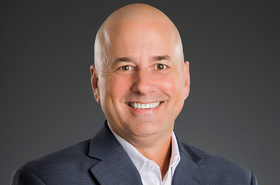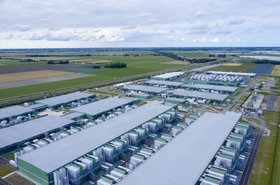As data center construction continues to expand at an exponential rate to meet demand, it’s not enough to simply find a site and start building. The process involves relationships with stakeholders ranging from power utility providers to the local community. Without them, delays and roadblocks are inevitable.
Powerhouse Data Centers has put these partnerships front and center of its offering at the six-hall ABX-1 development in Northern Virginia. As the company spreads its wings beyond its backyard, DataCenter Dynamics caught up with Powerhouse vice president of Data Center Development & Construction, Luke Kipfer to discuss the secrets of collaboration for success. We start by asking whether the way data center operators relate to potential clients has shifted.
“We have seen a fundamental change in the way hyperscalers are deploying their computing capacity. Five years ago, a hyperscaler picked an area, and other operators would follow them. Now hyperscalers are calling us and saying, ‘Where can you get land? Where can you get power?’ It's almost like the dichotomies have flipped. They're leaning more on teams like ours to be able to say, ‘Hey, I know you're looking here, but over here, I can get you 100 megawatts in a year and 300 acres’”.
Water and power
One of the most important bonds to form for any prospective data center is with utility companies. But it’s not as simple as just whether there’s access to the grid. Kipfer explains the many considerations at play in negotiating with power providers.
“It's not enough to know if there are transmission lines next to the site. You have to ask questions like – Are they capped? Is there capacity? How fast can you build a substation? And then the next step is, What's their utility? Is it renewable, nuclear, coal, or natural gas-fired? Then it’s about finding the right people to work with that utility – design teams, civil engineers, local zoning attorneys, entitlement zoning, permitting, and the best general contractors.”
Building the village
But it’s not enough to simply find your favorite contractor and stick with them. Different projects require different skill sets and even the most general contractors have their specialties.
“We work with the top data center general contractors in the world, but some are stronger in different markets than others, so having strong relationships with a variety of nationwide tier-one subcontractors and equipment suppliers is vital. We're a small team, and we leverage outside resources a lot. So much goes into the complexities – it's a big book of people that we rely on to execute these.”
Leveraging trust
A keyword in creating the village of our title is ‘trust’. We asked Kipfer if forming these partnerships during a first build can clear the way, making it easier when it’s time to expand.
“There's certainly a learning curve. Once you've already deployed projects in a specific market, you have a better understanding of where the pitfalls are and show that you can deliver. After our first project, we had a lot of positive responses. A lot of people drive by ABX-1 every day. That helps the ecosystem to say, ‘Yeah, these guys are here, we know they can get projects done’”.
On the subject of equipment provision, Kipfer also emphasizes that creating partnerships with suppliers can pay dividends in the fight to meet delivery timescales.
“In the past, it was very transactional, nowadays, you need to build relationships because it's not just about the price, it's about where you are in the line for ordering that equipment, and for example, if production slots come up through cancellations, do you have the relationship to be able to jump in and take them?”
Welcoming the locals
It would be easy to only talk of ‘community’ within the context of an industry bubble. But among the most important relationships to build are those with the real world. Kipfer emphasizes that these community relations are about more than just lip service.
“As we become more visible as an industry, we need to realize the importance of community relations. These are no longer just a single one-story building setback from the road. We need to do a better job as an industry of showing the benefits that data centers provide to communities – what that increase in tax base does.”
When you can put yourselves in the shoes of the community, it’s very easy to crystallize these benefits and understand how to convey them to potential refuseniks.
“There is a lot of bad press from neighbors that don't want data centers in their backyards, so it's important that we mitigate concerns and demonstrate the benefits to the community. As our industry grows, we need to be more proactive at building those relationships.”
Kipfer goes on to talk about the advantages to a community, compared to other forms of development that may be fighting for the same land.
“We're fulfilling a need. It's important to show communities that this is a public utility and the benefits compared to other uses – we're not increasing traffic, and we don’t put stress on local utility systems. It's a quiet building, generating a huge amount of tax revenue. There are always going to be people that are anti-development, but there are awesome benefits that we can provide.”
The Town Hall
Politics – be it at a local, state, or national level will always play a part in getting a data center built, and forming partnerships with officials is the next secret to Powerhouse’s success – and this is where exceeding expectations comes into play.
“Government officials are representatives of their constituents. If there is public outcry about data center developments, they're naturally going to be more restrictive. One way to build trust is going in over the minimum – exceeding the minimum amount of tree coverage, providing a mixed-use trail for public use, and an open space public park. It shows that you are rooted in the community and that the bottom line isn’t the only driver.”
Kipfer also warns of the potential risks of not taking this approach – not just for one project, but for the entire industry.
“The important thing we have to realize is that if we don't do a good job of self-regulating, it's going to be imposed on us, and it's not going to be the way we want it to be imposed. The way to get ahead is if we regulate and police ourselves and understand that these are very long-term relationships that we're building with the community – these aren't just pure real estate transactions, it's a partnership.”
One of the people
Power provision is at a premium in Northern Virginia, leading to another of Powerhouse’s key partnerships, with local utility provider Dominion. At the heart is the decision to build an on-site data center at its ABX-1 facility that goes beyond simply providing its own needs.
“The interconnect substation being built at our ABX-1 project provides 300MW of utility power; we are only using 60MW of that 300. The land we provided to Dominion will help serve a greater community need for more power in the Ashburn area. We take the approach of offering to give, not just take, and we can adjust our plan if it helps deploy the infrastructure that will both benefit us and the community.”
Watching the flowers grow
When it comes to winning hearts and minds, there’s no bigger topic than that of sustainability. We ask Kipfer if he believes that the data center industry is not only doing enough for the planet but also convincing stakeholders that data centers are sustainable use of land to meet climate goals.
“The level of conversation has gotten to where it needs to be. Less so the actual deployment and change. Big hyperscalers have set sustainability goals that are driving the market, and it's filtering through. In five years, this is going to be a better industry. We've still got a way to go but it feels like everyone's pushing in the same direction.”
As Kipfer points out – the alternative to surprise and delight is regulation, and that makes it all the more important that constructors take commitment to community and sustainability seriously.
“At the moment, we’re self-regulating, we're setting goals that are far more advanced than PUE or WWE, and tracking carbon. If we show as an industry that we’re deploying responsibly, and actively moving towards sustainability goals, it takes pressure off governments to impose regulations on us.”
If you build it, they will come
Our next ‘villagers’ are proving to be some of the most challenging. Attracting talent is a problem across all verticals, but the data center industry is having a tougher time than most. Kipfer warns of the potential risk that neglecting talent acquisition presents.
“I see data center staffing as one of the biggest risks of the industry, in spite of its growth and uniqueness. Some of these markets are so busy because they can't get people right. When you're so understaffed, you can barely get your projects done, let alone consider sustainability initiatives. Having the right amount of qualified staffing is what will allow us to get to the next level. Any less will be a constraint.”
Diplomatic relations
Now we have our village and everything works in harmony. But being isolated from the wider world is not practical – yet so much of the data center industry remains shrouded in mystery, with limited cooperation and information sharing. Kipfer believes that open information sharing between “neighboring villages” will benefit everyone.
“That's one of our biggest problems – everything is very secretive, siloed, and proprietary. Hyperscalers are secretive, which leads developers, general contractors, and designers to be secretive too. If we collaborated, it would move everyone together, faster.”
So how do we break down that mutual suspicion and start a spirit of openness between data center businesses?
“It’s an iterative delivery. They're not gonna say, all of a sudden, ‘Hey, we're open book!’, but it starts with little things like sustainability. You can get your foot in the door and go from there. If we were all deploying compute in the same way, the efficiencies would be amazing. It starts with baby steps, then, build on that and open more transparency in the industry.”
The bottom line of our discussion is clear. To make a data center successful, planning and building in isolation is not only undesirable – it’s impossible, because, like a village, it is a community effort – a whole greater than the sum of its parts, and success comes from looking outwards to the environment it is built on, and beyond.
More from PowerHouse Data Centers
-

Sponsored The top 7 ways to pinpoint and build your perfect data center location
And why choosing the right data center developer is key
-

Sponsored How PowerHouse bakes in sustainability from blueprint to build
Constructing a data center sustainably is about more than just the materials. PowerHouse is working to make new builds sustainable by design
-

Sponsored Disrupting the data center dynamic
How to become a data center disruptor in markets that have run out of available space

